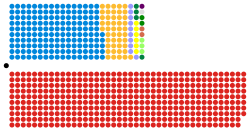1997 United Kingdom general election
| How an Empire ends U.K. Politics |
| God Save the King? |
The 1997 UK general election is mainly remembered for two things; the end of eighteen years of Conservative rule with a defeat so heavy that they had the fewest MPs since 1906 and lowest vote-share ever (until 2024 that is), and the installation of New Labour under Tony Blair which would last itself until 2010. It was also notable for the first internet coverage[1], the best showing for a third party (the Liberal Democrats) since 1929 and bringing to power the youngest Prime Minister since 1812. It also gave Britons the first taste of modern, multi-angled political 'spin' from slick willies like Alistair Campbell. Perhaps more ominously, it saw the anti-EU 'Referendum Party' garnish some 800,000 votes (about 2.6% of the total) nationally, which directly fed into the poisonous populists of UKIP.
Background[edit]
After coming from behind to win a sneaky fourth victory in 1992, the Conservatives promptly tripped over on 'Black Wednesday'[2] – a situation which caused an devaluation of Sterling (netting George Soros $1 billion of the Bank of England's money) which finally trashed their reputation of 'being good with the economy' which extended the recession by perhaps six months and sent their poll numbers down by fifteen points. There it stayed, as John Major got to preside over a party increasingly unable to keep it's trousers up[3], to say no to mysterious envelopes filled with cash[4], to realise when they were being tone-deaf[5][6] or from knifing each other over 'Europe'[7] (which with hindsight, was the prelude to the political war which became Brexit). Major's work also grew correspondingly harder through the Parliament, as his original majority of 21 was slowly whittled down by defections, deaths and resignations that by 1996 he'd lost his majority and was dependent on the Ulster Unionists on avoiding total governmental collapse.
Other items of note in his tenure was the piles of burning cattle due to BSE[8], his timidity (or caution) over intervening in the Yugoslav Wars[9], the on-off cease-fire from the IRA[10], ill-considered policies such as the 'Cones Hotline'[11] or simple examples of right wing stupidity and/or prejudice from Tory MPs we would now call attempts to create a 'culture war' (or just signs the average member was still mentally living in the 1950s).
Campaign[edit]
The Conservatives ran a confused campaign, unsure whether to demonise Labour[12] or mock them for stealing their own policies. That is, when they weren't attacking themselves or being spooked by the rise of the astroturfed Referendum Party who'd got enough money to send millions of election videos to voters (another UK first).[13] The truth was a bit sadder than this; they knew they'd lose, only wondered by how much.
Labour went on the offensive with a content-light media campaign, mainly filled with similar happy-talk and windy Third Way uplift which had gotten Bill Clinton into the White House twice. This pissed off the more socialist end of their base, but by this point they were pretty hungry for power and would put up with almost anything to get it. One key asset was that of Tony Blair; a man who's clear, easy charisma and energy was in stark contract with the 'dull' Major, a man who appeared older, duller and straight-laced than he actually was.
The Liberal Democrats, not being fools saw how the wind was blowing due to Blair and the general lack of Labour-Liberal marginals seemed to have reached a 'non-aggression' pact between them to focus the fire (and tactical voting) against the incumbents (a pact which is now known to have been 'officially unofficial'[14]).
Results[edit]

On the whole, the strategy worked — a Labour landslide, a 'working majority' of 182. A significant percentage of Labour supporters voted tactically for Liberals (and vice-versa); allowing the latter to more than double their seats despite a slight drop in total votes. The Conservatives lost a significant portion of their 'front bench', and were reduced to an England-only party. It also marked the start of the rise of the SNP; doubling to six MPs.
| Turnout: 71.3% (-6.3%) | Seats | Change | Vote % | Change |
|---|---|---|---|---|
| Labour | 419 | +146 | 43.2 | +8.8 |
| Conservatives | 165 | -178 | 30.7 | -11.2 |
| Liberal Democrats | 46 | +28 | 16.8 | -1.0 |
| Other | 29 | +5 | 9.3 | +3.4 |
External links[edit]
- BBC's 'Election '97' site; still (mainly) functional.
References[edit]
- ↑ Election 97: The first online election BBC News, 4 September 2017
- ↑ Black Wednesday 20 years on: how the day unfolded The Guardian, 13 September 2012
- ↑ The Yeo Resignation: Minister falls foul of 'back to basics' policy: Swift demise after constituency association released statement The Independent, 6 January 1994.
- ↑ A lair and a cheat The Guardian, 1 October 1996.
- ↑ Ah, I remember this sickly smell of sleaze The Guardian, 12 April 2009
- ↑ Sex, Lies and Hypocrisy: The last time Sleaze brought down the Tories Tides of History, 23 December 2017
- ↑ Major Wins Confidence Vote on Europe Treaty Los Angeles Times, 24 July 1993
- ↑ Mad cow disease – a very British response to an international crisis The Guardian, 25 April 2012
- ↑ Major, the chicken turned hawk The Guardian, 11 April 1999
- ↑ The 1996 Manchester bomb: A day that changed our city forever Manchester Evening News, 15 June 2024
- ↑ Cones Hotline put into cold storage The Independent, 20 September 1995.
- ↑ 'New Labour, New Danger' Conservative Party attack poster, 1997 The Times, 25 March 2015
- ↑ Sir James Goldsmith and the Referendum Party WorldPR, 5 June 2020
- ↑ Inside story of 1997 Labour–Lib Dem deal Compass Online, 23 May 2022

